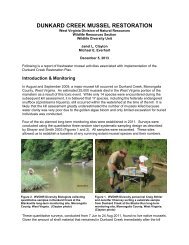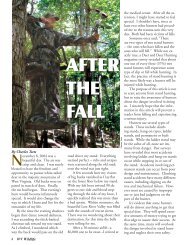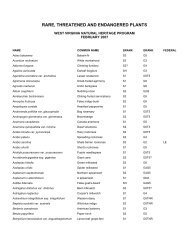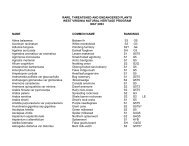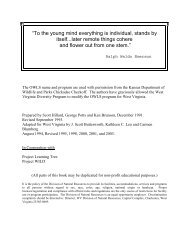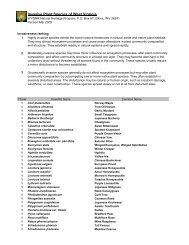Snakes - West Virginia Division of Natural Resources
Snakes - West Virginia Division of Natural Resources
Snakes - West Virginia Division of Natural Resources
Create successful ePaper yourself
Turn your PDF publications into a flip-book with our unique Google optimized e-Paper software.
<strong>Snakes</strong><br />
<strong>of</strong> <strong>West</strong> <strong>Virginia</strong><br />
Northern Copperhead<br />
<strong>West</strong> <strong>Virginia</strong><br />
<strong>Division</strong> <strong>of</strong> <strong>Natural</strong> <strong>Resources</strong><br />
Wildlife <strong>Resources</strong> Section<br />
1
<strong>West</strong> <strong>Virginia</strong><br />
<strong>Division</strong> <strong>of</strong> <strong>Natural</strong> <strong>Resources</strong><br />
Wildlife <strong>Resources</strong> Section<br />
WILDLIFE DIVERSITY PROGRAM<br />
P. O. Box 67, Ward Road<br />
Elkins, WV 26241<br />
WWW.WVDNR.GOV<br />
Cover photograph <strong>of</strong> Northern Copperhead by Larry D. Belcher.<br />
Note: Copperheads have an elliptical pupil, as do Timber Rattlesnakes,<br />
the only venomous snakes in <strong>West</strong> <strong>Virginia</strong>.<br />
2
<strong>Snakes</strong> Of <strong>West</strong><br />
<strong>Virginia</strong><br />
Because <strong>of</strong> irrational fears, snakes are perhaps the most misunderstood<br />
creatures in <strong>West</strong> <strong>Virginia</strong>. These fears that are passed from<br />
one generation to another make many state residents shudder at<br />
the very thought <strong>of</strong> snakes. Yet these members <strong>of</strong> the reptile class play<br />
a vital role in the balance <strong>of</strong> nature. Their colorful and complex life<br />
histories are fascinating and give little justifi cation for the apprehension<br />
felt by so many.<br />
The fear <strong>of</strong> being bitten causes many persons to senselessly kill any<br />
snake they see. Yet, <strong>of</strong> the 20 species <strong>of</strong> snakes found in the Mountain<br />
State, only two are venomous, the Northern Copperhead and Timber<br />
Rattlesnake. Although the majority <strong>of</strong> venomous snake bites in <strong>West</strong><br />
<strong>Virginia</strong> are from copperheads, no fatalities from copperheads have been<br />
recorded in over 30 years. From 1969 to 1992 only four people in the<br />
Mountain State have died from rattlesnake bites while in the wild. Bee<br />
stings, cows and horses caused 15 times as many deaths as snakes. Up<br />
to one-half <strong>of</strong> venomous snake bites result in no venom being injected.<br />
If, however, you are bitten by a venomous snake, see a doctor or go to a<br />
hospital immediately.<br />
While the danger from snake bites is exaggerated, the ecological<br />
value <strong>of</strong> snakes is <strong>of</strong>ten overlooked. <strong>Snakes</strong> provide an essential<br />
pest-control service as a result <strong>of</strong> their feeding habits. While all snakes<br />
contribute to this service, some species are particularly benefi cial. Both<br />
species <strong>of</strong> black snakes, kingsnakes, Timber Rattlesnakes and Eastern<br />
Milksnakes are well-known rodent predators. Enlightened <strong>West</strong> <strong>Virginia</strong><br />
farmers encourage black snakes to make their home in the barn where<br />
the harmless reptile controls rat and mouse populations. While smaller<br />
kingsnakes consume large quantities <strong>of</strong> insects, larger kingsnakes may<br />
also feed on snakes.<br />
Understanding the feeding<br />
habits <strong>of</strong> snakes is important if<br />
one wants to control them.<br />
<strong>Snakes</strong> can be discouraged<br />
from staying around yards<br />
and buildings by eliminating food<br />
and cover attractive to them. Because many<br />
snakes feed on rodents, it is advisable to make<br />
Mountain Earthsnake<br />
3<br />
Sam Norris
all buildings rodent-pro<strong>of</strong> if one does not want the company <strong>of</strong> snakes.<br />
Closely-mowed lawns and fields are less attractive to snakes than areas<br />
<strong>of</strong> tall grass, weeds or brush. <strong>Snakes</strong> seek food and cover under boards,<br />
flat rocks, trash piles and similar materials. By eliminating such shelter,<br />
one can <strong>of</strong>ten eliminate snakes. However, removing such shelter may be<br />
impractical around farms.<br />
<strong>Snakes</strong> occasionally enter homes, sometimes by accident or sometimes<br />
while searching for hibernation quarters or mice. Those entering<br />
homes are almost always the harmless, nonvenomous kinds. <strong>Snakes</strong> can<br />
pass through extremely small spaces and usually enter buildings near<br />
ground level. Cellar doors, windows and screens should fit tightly; walls<br />
and floors should be inspected for crevices. Spaces around pipes that<br />
enter from the outside should be plugged, and galvanized screen can be<br />
fastened over other possible points <strong>of</strong> entry to keep snakes from entering<br />
dwellings. Mothballs, quick lime or sulphur, contrary to popular<br />
opinion, are not effective snake repellents.<br />
The 20 species <strong>of</strong> snakes found in <strong>West</strong> <strong>Virginia</strong> range in<br />
size from about 10 inches to more than six feet in length. <strong>Snakes</strong> are<br />
complex and highly adapted animals that inhabit a variety <strong>of</strong> habitats.<br />
Color, size, shape, preferred habitat and geographical range are summarized<br />
in this brochure.<br />
Eastern Gartersnake<br />
4
Mark Watson<br />
QUEEN SNAKE (Regina septemvittata)<br />
This slender, brown or gray aquatic snake has a yellowish stripe<br />
along the lower sides <strong>of</strong> its body and the yellowish belly is marked with<br />
four brown<br />
longitudinal<br />
stripes. Scales<br />
are strongly<br />
keeled (have<br />
a ridge down<br />
the center).<br />
Queen <strong>Snakes</strong><br />
may grow to<br />
nearly three<br />
feet in length.<br />
They are found<br />
throughout the<br />
state, especially<br />
in small, rocky<br />
creeks and rivers.<br />
They feed<br />
on crayfish and other small aquatic animals. Females give birth to 5 to<br />
31 live young which are approximately 7-8 inches long.<br />
COMMON WATERSNAKE (Nerodia s. sipedon)<br />
On this snake the dorsal color pattern is a series <strong>of</strong> reddish-brown<br />
to black blotches on a background <strong>of</strong> pale gray to dark brown. The<br />
scales are heavily keeled. Their yellow to orange belly is liberally marked<br />
with dark crescent-shaped blotches. Watersnakes may exceed 4 feet in<br />
length. This is a<br />
very common and<br />
widely distributed<br />
species which is<br />
found along small<br />
streams, ponds<br />
and rivers where<br />
it feeds on fish,<br />
frogs and other<br />
aquatic animal<br />
life.<br />
5<br />
John MacGregor
Up to 50 young, which are six to nine inches long, are born each year.<br />
The Common Watersnake is probably the most defensive snake in<br />
the state and is popularly referred to as the “water moccasin,” not to be<br />
confused with the Eastern Cottonmouth (Agkistrodon p. piscivorus), a<br />
venomous species found to our south. There are no confirmed records<br />
<strong>of</strong> the cottonmouth or any venomous water snakes occurring within<br />
<strong>West</strong> <strong>Virginia</strong>.<br />
NORTHERN BROWNSNAKE (Storeria d. dekayi)<br />
This small brown snake has two rows <strong>of</strong> black dots down its back<br />
and 17 rows <strong>of</strong> keeled scales. It may grow to nearly 20 inches in length<br />
and is found most frequently in moist woodlands where it feeds on small<br />
invertebrates such as slugs, snails, insects and earthworms. Up to 14<br />
young approximately four inches in length may be produced.<br />
NORTHERN RED-BELLIED SNAKE (Storeria o.<br />
occipitomaculata)<br />
This small brownish snake is usually less than 16 inches in length<br />
and may have a light brown stripe down its back, three distinct yellowish<br />
spots at the base <strong>of</strong> its head, a red belly (although about 10 percent <strong>of</strong><br />
these snakes have a gray or black belly in <strong>West</strong> <strong>Virginia</strong>) and 15 rows <strong>of</strong><br />
keeled scales.<br />
6<br />
Tom Allen
Red-bellied <strong>Snakes</strong> may be found throughout the state in wooded<br />
areas where they feed on slugs and other invertebrates. As many as 13<br />
young, approximately three inches long, are born per litter.<br />
COMMON RIBBONSNAKE (Thamnophis s. sauritus)<br />
This very slender snake is <strong>of</strong>ten confused with the Eastern Gartersnake.<br />
The Ribbonsnake has a long tail which makes up about one-third<br />
<strong>of</strong> its total length and has three distinct yellow longitudinal stripes on a<br />
rich brown background; one stripe is down the middle <strong>of</strong> its back while<br />
the other two appear on its sides on the third and fourth rows <strong>of</strong> scales.<br />
Ribbonsnakes may grow to three feet in length and inhabit wetlands,<br />
especially swampy or marshy areas, where they feed on small aquatic vertebrates<br />
and invertebrates. Few records exist for Ribbonsnakes in <strong>West</strong><br />
<strong>Virginia</strong>. Approximately 10-12 young which are six to nine inches long<br />
are born each year.<br />
7<br />
Mark Watson<br />
Tom Allen
John MacGregor<br />
EASTERN GARTERSNAKE (Thamnophis s. sirtalis)<br />
This snake is quite variable in color, ranging from greenish, brownish<br />
or grayish with sometimes indistinct lateral stripes on the second and<br />
third scale rows. Gartersnakes are common in <strong>West</strong> <strong>Virginia</strong>. They may<br />
attain a length <strong>of</strong> four feet, and are frequently encountered in meadows,<br />
marshes, hillsides and city lots or buildings where they feed on any small<br />
animal they can catch. Up to 80 young, approximately three inches in<br />
length, may be produced.<br />
EASTERN SMOOTH EARTHSNAKE (<strong>Virginia</strong> v. valeriae)<br />
There are two subspecies <strong>of</strong> earthsnakes in the state, the Eastern<br />
Smooth Earthsnake described here and the Mountain Earthsnake<br />
described in the following account. The Eastern Smooth Earthsnake is<br />
secretive spending most <strong>of</strong> its time underground where it feeds on earthworms<br />
and other small<br />
invertebrates. Earthsnakes<br />
seldom exceed<br />
one foot in length and<br />
have smooth dorsal<br />
scales that are gray to<br />
brown. The belly is<br />
plain white or creamcolored.<br />
About ten<br />
young, averaging 3½<br />
- 4½ inches long, are<br />
born per litter.<br />
8<br />
Mark Watson
Zac Loughman<br />
MOUNTAIN EARTHSNAKE (<strong>Virginia</strong> valeriae pulchra)<br />
The Mountain Earthsnake has been reported from Pendleton,<br />
Pocahontas, Preston<br />
and Randolph counties<br />
and may occur in<br />
other nearby counties.<br />
Its habits are similar to<br />
the Eastern Earthsnake<br />
but morphologically<br />
it differs in having<br />
weakly keeled scales<br />
and a scale row count<br />
<strong>of</strong> 17 at midbody (the<br />
eastern earthsnake has<br />
15). Food habits and<br />
young are similar to the Eastern Earthsnake.<br />
EASTERN HOG-NOSED SNAKE (Heterodon platirhinos)<br />
The distinctive feature <strong>of</strong> this species is an upturned snout which is<br />
used in rooting for toads, its major food item. Hog-nosed <strong>Snakes</strong> may<br />
be spotted with squarish blotches <strong>of</strong> bluish black on a tan background<br />
while some specimens are completely black. Hog-nosed <strong>Snakes</strong> have<br />
keeled scales and <strong>of</strong>ten attain lengths <strong>of</strong> more than 40 inches. They occur<br />
throughout the state in woodlands, along sandy edges <strong>of</strong> rivers and<br />
streams and in cultivated fi elds. Approximately 20-30 oval, white eggs<br />
are deposited in loose sandy soil.<br />
The defensive actions <strong>of</strong> this snake are responsible for its being<br />
feared by many people. Hissing, fl aring its head and neck, and feigned<br />
strikes (with the mouth closed) have led to such names as blowing viper,<br />
The color variations <strong>of</strong> Hog-nosed<br />
<strong>Snakes</strong> are dramatic, as these two<br />
photos illustrate.<br />
9<br />
Mark Watson Mark Watson
spreading adder and<br />
puff adder. Finding<br />
its bluff ineffective,<br />
Hog-nosed <strong>Snakes</strong><br />
“play possum” by<br />
twisting and turning<br />
on their back and<br />
assuming the posture<br />
<strong>of</strong> a dead snake.<br />
However, if turned<br />
over on the belly, the<br />
snake will immedi- Hog-nosed Snake playing dead.<br />
ately flop over on their backs again. Hog-nosed <strong>Snakes</strong> are among <strong>West</strong><br />
<strong>Virginia</strong>’s most unusual and interesting snakes.<br />
NORTHERN RING-NECKED SNAKE (Diadophis punctatus<br />
edwardsii)<br />
Ring-necked <strong>Snakes</strong> are distinctly marked with a bright yellow<br />
or orange belly, a glossy bluish gray or black back, and a bright yellow<br />
neck band. They rarely exceed 20 inches in length and are a secretive<br />
species that may be found in rotting logs, piles <strong>of</strong> dead leaves or under<br />
rocks.They feed on insects and small animal life. Ring-necks are widely<br />
distributed throughout the state. Up to ten small white oval eggs are laid<br />
per clutch.<br />
10<br />
Ed McCrea/USFWS<br />
Mark Watson
Mark Watson<br />
EASTERN WORMSNAKE (Carphophis a. amoenus)<br />
Smooth scales, a small pointed head and a tail ending in a spinelike<br />
tip identify the Eastern Wormsnake. Seldom exceeding one foot in<br />
length, Wormsnakes have been collected throughout the state from bur-<br />
rows in the soil, organic debris and rotting logs. Prey consists <strong>of</strong> insects<br />
and earthworms. Two to six small, white, elliptical eggs are laid under<br />
rocks, in loose soil or rotting wood.<br />
NORTHERN BLACK RACER (Coluber c. constrictor)<br />
This snake is slender, glossy black in color and may attain a length<br />
<strong>of</strong> six feet The dorsal scales are smooth and the chin and throat are<br />
white. Black Racers<br />
occur throughout the<br />
state in moist woodlands<br />
and fields, where<br />
they feed on birds and<br />
mammals, as well as<br />
amphibians and reptiles.<br />
Approximately 25<br />
<strong>of</strong>f-white, elliptical eggs<br />
are deposited in loose<br />
soil or sawdust piles. Hatchlings have 30 or more reddish brown blotches<br />
on a gray background. The banded juvenile pattern slowly disappears<br />
as the snake grows larger, and the snake is completely black by the time<br />
it reaches 30 inches in length.<br />
11<br />
Mark Watson
NORTHERN ROUGH GREENSNAKE (Opheodrys a. aestivus)<br />
This slender greensnake has a white or yellow belly, keeled scales<br />
and a tail that comprises one-third <strong>of</strong> its total length. Rough Greensnakes<br />
may attain a length <strong>of</strong> 45 inches and are usually found in vines,<br />
bushes or grass where<br />
it feeds on small<br />
insects and spiders.<br />
They occur at low elevations<br />
in the western<br />
and central parts <strong>of</strong><br />
the state but are absent<br />
in the mountains<br />
where Smooth Greensnakes<br />
are found. Up<br />
to 14 small, elliptical,<br />
cream-colored eggs<br />
are deposited in loose<br />
earth or under debris. Greensnakes are harmless and docile.<br />
SMOOTH GREENSNAKE (Opheodrys vernalis)<br />
This is the other light green snake with a yellow belly. Its scales<br />
are smooth and it is not as slender as the Rough Greensnake. Growing<br />
to approximately<br />
two feet in length,<br />
Smooth Greensnakes<br />
are more <strong>of</strong>ten<br />
found in grass than<br />
in bushes. Its living<br />
habits are similar to<br />
the Rough Greensnake,<br />
but it occurs<br />
only in the mountainous<br />
areas <strong>of</strong> eastern<br />
<strong>West</strong> <strong>Virginia</strong>.<br />
Up to 13 eggs have<br />
been reported.<br />
12<br />
Mark Watson<br />
Mark Watson
Mizuki Takahashi<br />
CORNSNAKE (Elaphe g. guttata)<br />
Red dorsal blotches<br />
outlined in black against<br />
a light brown background<br />
make this one <strong>of</strong> our most<br />
attractive snakes. Cornsnakes<br />
can reach six feet<br />
in length and its scales<br />
are weakly keeled. Cornsnakes<br />
have been collected<br />
in Eastern Panhandle<br />
farmlands where they feed<br />
on small rodents. About<br />
10-15 white, elliptical<br />
eggs are deposited each<br />
year.<br />
BLACK RATSNAKE (Elaphe o. obsoleta)<br />
This common and useful snake may exceed 6 feet in length, which<br />
makes it one <strong>of</strong><br />
our state’s largest<br />
snakes. This<br />
shiny black reptile<br />
normally exhibits<br />
traces <strong>of</strong> its<br />
spotted juvenile<br />
pattern (light cross<br />
bars <strong>of</strong> white,<br />
cream or yellow)<br />
throughout its<br />
adult life. The<br />
belly is light-col-<br />
Nonvenomous juvenile Black Ratsnakes,<br />
right, are <strong>of</strong>ten misidentifi ed as venomous<br />
Copperheads. The former’s bands are more<br />
close together, while the Copperhead’s bands<br />
are spaced further apart and have a more<br />
hourglass shape.<br />
13<br />
Tom Allen<br />
Nanci Bross-Fregonara
ored with alternating blotches that create a checkerboard effect. The<br />
dorsal scales are weakly keeled. Black Ratsnakes are found in a variety <strong>of</strong><br />
habitats–houses, barns, fields, brushlands, woodlands and streams–where<br />
they feed on a variety <strong>of</strong> rodent and other warm-blooded prey, including<br />
birds and their eggs. Usually 10-14 elliptical, chalky-white eggs are<br />
deposited in loose soil.<br />
NORTHERN<br />
PINESNAKE (Pituophis<br />
m. melanoleucus)<br />
This spotted snake has<br />
black or dark brown blotches<br />
on a white or light gray background.<br />
Pinesnakes have a<br />
distinctively audible hiss and<br />
may reach a length <strong>of</strong> over six<br />
feet. This woodland snake<br />
feeds on small mammals and<br />
other warm-blooded prey. In <strong>West</strong> <strong>Virginia</strong> it is known from only one<br />
section <strong>of</strong> Monroe County where just one specimen has been collected.<br />
Approximately 3-24 whitish, elliptical eggs are laid annually.<br />
EASTERN KINGSNAKE (Lampropeltis g. getula)<br />
There are two subspecies <strong>of</strong> kingsnakes in the Mountain State. The<br />
shiny black Eastern Kingsnake has a vivid yellow or white chain-like<br />
pattern along its back. Scales are smooth and the anal plate is single. It<br />
14<br />
Tom Allen<br />
WVDNR Photo
Mark Watson<br />
may attain a length <strong>of</strong> six feet. An uncommon species in <strong>West</strong> <strong>Virginia</strong>,<br />
Eastern Kingsnakes are found only in the valley <strong>of</strong> the South Branch <strong>of</strong> the<br />
Potomac River. Kingsnakes received their name from their habit <strong>of</strong> eating<br />
other snakes, including venomous ones. They also feed on frogs, lizards<br />
and mammals. Up to 24 white, elliptical eggs are laid in loose earth.<br />
EASTERN BLACK KINGSNAKE (Lampropeltis g. niger)<br />
This reptile is<br />
similar to the Eastern<br />
Kingsnake in living<br />
habits, size and appearance,<br />
except that<br />
the chainlike pattern<br />
is not as bold or<br />
pronounced. Some<br />
specimens are almost<br />
totally black with<br />
small flecks <strong>of</strong> yellow.<br />
Black Kingsnakes<br />
differ from the Black<br />
Ratsnake in having<br />
smooth scales and a single anal plate. It has been collected in Cabell,<br />
Kanawha, Lincoln, Mason, Putnam and Wayne counties.<br />
EASTERN MILKSNAKE (Lampropeltis t. triangulum)<br />
This spotted snake has a row <strong>of</strong> large brown or reddish brown<br />
blotches on a background <strong>of</strong> gray along its back and smaller blotches<br />
along the sides<br />
which alternate<br />
with the<br />
larger dorsal ones.<br />
Milksnakes are<br />
<strong>of</strong>ten mistaken<br />
for Copperheads.<br />
The belly is white<br />
with black checkerboard<br />
markings,<br />
the dorsal scales<br />
are smooth, and<br />
the anal plate is<br />
single. Lengths seldom exceed 40 inches. Milksnakes occur throughout<br />
the state in a variety <strong>of</strong> habitats. The name milksnake comes from the<br />
15<br />
John MacGregor
Mark Watson<br />
erroneous folk lore that it enters barns and attaches itself to the udder <strong>of</strong><br />
a cow and drinks her milk. Approximately 3-20 small, white elliptical<br />
eggs are deposited in loose earth.<br />
NORTHERN COPPERHEAD (Agkistrodon contortrix mokasen)<br />
This is one <strong>of</strong> the two venomous snake species in <strong>West</strong> <strong>Virginia</strong>.<br />
The color is a rich, reddish brown with a series <strong>of</strong> darker hourglass<br />
markings down its back. The bright copper colored head, pinkish belly,<br />
single anal plate, keeled scales and facial pit identify copperheads. Copperheads<br />
average<br />
two feet in length<br />
and seldom exceed<br />
three feet. This is the<br />
only <strong>West</strong> <strong>Virginia</strong><br />
snake that has dark<br />
bands across its back<br />
which are narrow on<br />
the back and broad<br />
on the sides–similar<br />
to an hourglass or<br />
saddlebag shape.<br />
Copperheads exist<br />
throughout the<br />
state in rocky, wooded areas where they feed on small rodents and other<br />
warm-blooded prey. Occasionally, they may also feed on aquatic animals<br />
and insects. Approximately 3-15 young which are 8-9 inches in length<br />
are produced. Copperheads do not interbreed with blacksnakes.<br />
TIMBER RATTLESNAKE (Crotalus horridus)<br />
This venomous reptile is the only species <strong>of</strong> snake in the state with<br />
a segmented rattle at the end <strong>of</strong> its tail. It has brown or black chevron-shaped<br />
markings down its back. The background color may vary<br />
from bright yellow to a dull<br />
gray. However, entirely black<br />
specimens have been recorded.<br />
Rattlesnakes rarely exceed six<br />
feet in length. Usually a docile<br />
snake, rattlers usually occur in<br />
remote, rocky, mountainous sections<br />
<strong>of</strong> the state. From 3 to 19,<br />
but usually about 8, young may<br />
be born which are 10-19 inches<br />
16<br />
Larry D. Belcher
Litter <strong>of</strong> young (7-14 days old)Timber Rattlesnakes. Their coloration will change as they age.<br />
long. The pit viper’s habit <strong>of</strong> congregating at dens creates situations<br />
where considerable numbers <strong>of</strong> rattlesnakes and copperheads can be seen<br />
at one time.<br />
Handling Nonvenomous <strong>Snakes</strong><br />
Being bitten by a nonvenomous snake is nothing to be concerned<br />
or excited about. A bite from a one-or two-foot snake can hardly be felt.<br />
A bite from a 5-foot snake may hurt, but is usually not serious. First<br />
aid should consist <strong>of</strong> cleansing the bite with soap and an antiseptic. A<br />
bandage is rarely needed.<br />
Most snakes will try to bite only when you attempt to pick them<br />
up. This is their natural reaction to something as large and threatening<br />
as a person. When handling a nonvenomous snake, support the snake<br />
evenly with both hands for several minutes to allow it to become accustomed<br />
to its predicament. Then slowly release the head while fully<br />
supporting its body with both hands. If the snake tries to move quickly<br />
(which some do) continue the hand-over-hand motion to maintain<br />
support. The idea is to make the snake feel secure and not in danger <strong>of</strong><br />
being dropped. Some snakes, such as Black Ratsnakes will calm down<br />
within 15 minutes or so. They generally do not bite indiscriminately<br />
while being handled, but may bite when you try to pick them up for the<br />
fi rst several times. They usually become accustomed to handling after a<br />
few days.<br />
Be advised that other snakes such as Black Racers do not allow itself<br />
to be handled in this manner and are usually quite defensive and quick<br />
compared to Black Ratsnakes.<br />
17<br />
David Garst
Illustrations by Sam Norris<br />
Identifying Nonvenomous<br />
And Venomous <strong>Snakes</strong><br />
Nonvenomous snakes are <strong>of</strong>ten erroneously identifi ed as venomous.<br />
There are three reliable characteristics, in addition to the rattlesnake’s<br />
rattle, which may be used to separate <strong>West</strong> <strong>Virginia</strong>’s harmless snakes<br />
from the venomous copperhead and rattlesnake: the shape <strong>of</strong> the pupil<br />
in the eye; presence or absence <strong>of</strong> the sensory pits; and scale patterns on<br />
the underside <strong>of</strong> the tail. In addition, our venomous snakes have broad,<br />
fl attened, arrow-shaped heads, with narrow necks. The rattlesnake’s<br />
rattle is an obvious characteristic, but the tail shape <strong>of</strong> a copperhead is<br />
not really different than the tail <strong>of</strong> a nonvenomous snake.<br />
It is also useful to be able to distinguish copperheads from other<br />
snakes that have similar patterns, such as hog-nosed snakes, milksnakes<br />
and watersnakes, young black racers and black ratsnakes. Bands across<br />
the back <strong>of</strong> copperheads are hour-glass or saddlebag shaped, being narrowest<br />
along the top <strong>of</strong> the back. Bands across the back <strong>of</strong> other <strong>West</strong><br />
<strong>Virginia</strong> snakes are the same width, or wider across the top <strong>of</strong> the back<br />
(see illustration on following page). Knowing this difference in patterns<br />
will allow you to distinguish a copperhead from snakes with a similar<br />
pattern if you only catch a glimpse <strong>of</strong> a snake as it is crawling under<br />
a rock or building. Although you may not be able to determine the<br />
species, at least you will know whether or not it is a copperhead (and<br />
consequently whether you need to be concerned about the presence <strong>of</strong> a<br />
venomous snake in your yard or barn).<br />
The eyes <strong>of</strong> copperheads and rattlesnakes are also a quick and obvious<br />
way to separate these species from the nonvenomous snakes in <strong>West</strong><br />
Venomous snakes in <strong>West</strong> <strong>Virginia</strong> (top) have<br />
an elliptical pupil and a pit or opening (A)<br />
close to the nostril. Nonvenomous snakes<br />
(below) have a round pupil and no pit opening.<br />
A<br />
18<br />
<strong>Virginia</strong>. Pupils are elliptically<br />
shaped, like a cat’s eye. <strong>West</strong><br />
<strong>Virginia</strong> nonvenomous snakes<br />
have round pupils. A dark<br />
background makes it diffi cult<br />
to determine whether pupils are<br />
round on some snakes, but the<br />
copperhead’s and rattlesnake’s<br />
elliptical pupils are obvious.<br />
Both milksnakes and copperheads<br />
have eyes with dark pupils<br />
against an orange background.<br />
However, milksnakes, which<br />
are <strong>of</strong>ten confused with copper-
Venomous snakes (top)<br />
have broad, arrow-shaped<br />
heads with narrow necks.<br />
Nonvenomous snakes<br />
(below) have more slender<br />
heads.<br />
heads, have round pupils.<br />
Most people believe they cannot get close enough<br />
to a snake to determine the shape or color <strong>of</strong> the eyes;<br />
however, you can easily see the eyes <strong>of</strong> a snake from<br />
several feet away. This is a safe distance for observation<br />
because snakes can only strike, at most, one-half <strong>of</strong><br />
their body length.<br />
There are two general types <strong>of</strong> dorsal scales on<br />
snakes, keeled and smooth. Keeled scales have a ridge<br />
along the center <strong>of</strong> the scale. The keel breaks or scatters<br />
light giving species with keeled scales a dull appearance.<br />
Conversely, in snakes with scales that lack this keel<br />
(smooth scales) light is reflected resulting in a shiny or<br />
glossy appearnace. The use or significance <strong>of</strong> keeled<br />
versus smooth scales is not fully understood. All snakes<br />
have wide scales across the venter or belly. These scales<br />
are used for traction when a snake is crawling, much<br />
like the treads <strong>of</strong> a bulldozer. In venomous snakes (Timber<br />
Rattlesnakes and<br />
Nonvenomous snakes (top) have<br />
divided scales on the underside <strong>of</strong> their<br />
tail. Venomous snakes (below) have<br />
undivided scales under their tail.<br />
Northern Copperheads<br />
in <strong>West</strong> <strong>Virginia</strong>), these<br />
ventral scales continue onto<br />
the tail as a single scale. In our nonvenomous<br />
snakes, ventral scales on<br />
the tail are divided.<br />
19<br />
Above: Bands across the back <strong>of</strong><br />
Copperheads (on left) are hour-glass or<br />
saddlebag shaped, being narrowest along<br />
the top <strong>of</strong> the back. Bands across the back<br />
<strong>of</strong> other <strong>West</strong> <strong>Virginia</strong> snakes (on right)<br />
are <strong>of</strong>ten the same width, or wider across<br />
the top <strong>of</strong> the back.
For more information on snakes<br />
and all other reptiles and amphibians<br />
found in <strong>West</strong> <strong>Virginia</strong>, refer<br />
to Amphibians and Reptiles in <strong>West</strong><br />
<strong>Virginia</strong> by Drs. N. Bayard Green and<br />
Thomas K. Pauley.<br />
Copy credited to the late Dr. N.<br />
Bayard Green, Mr. Frank Jernejcic,<br />
Dr. Thomas K. Pauley and Mr. Duane<br />
Pursley.<br />
<strong>West</strong> <strong>Virginia</strong> <strong>Division</strong> <strong>of</strong> <strong>Natural</strong> <strong>Resources</strong><br />
Wildlife <strong>Resources</strong> Section<br />
Wildlife Diversity Program<br />
P.O. Box 67<br />
Elkins, WV 26241<br />
304-637-0245<br />
www.wvdnr.gov<br />
The <strong>Division</strong> <strong>of</strong> <strong>Natural</strong> <strong>Resources</strong> is an equal<br />
opportunity employer.<br />
02/06 10M<br />
20



